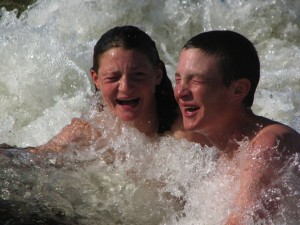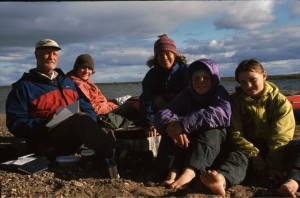Call it parental revelation.
The three of them range out in front, dots of colorful energy bushwhacking across the tundra above 10,000’, deep in the Washakie Wilderness of northern Wyoming. Ruby, 11, Sawyer, 13, and Eli, 14. They look so small. At the same time, they exude confidence and zeal. We can hear them calling to each other, urging each other on, eager for the next corner. Their exuberance and independence is absolute, obvious at 100 yards.
We are 25 miles from the trailhead, on our way to the summit of Younts Peak, which overlooks the forks of the Yellowstone River from better than 12,000’. The ramparts of the blocky summit rise above the valley, intimidating and enticing. First, though, and more important, we seek the literal headwaters of the Yellowstone, that first drip of river off of the snout of snowfield, the river we have come to know intimately as a family. A month earlier we finished canoeing its entire 550-mile navigable length, from the Yellowstone Park boundary to the confluence with the Missouri in North Dakota.
To get here the kids carried full packs up the trail, up thousands of feet, over several days. Hiking ten miles a day with a few thousand vertical thrown in has been routine. They have earned this unburdened ramble to the summit, and this quest for the source of the river so fresh in our collective experience.
I watch them, savoring their energy, the distant snatches of their banter; savoring how at home they all are here. And I think, what if we had waited?
What if we had followed that cliché of American conventional wisdom to ‘Wait until they’re old enough’? If we had, we might just now be ramping up the first outing, pulling them away from their other commitments – soccer, friends, the city pool. We might be lucky or persuasive enough to wrench them out of their comfort zones and lure them down the trail, into a canoe, up a mountainside, but it would be a struggle. And once there, we would only now be starting the education in how to live comfortably in the wilds, how to pace yourself with a pack on, how to detect and take care of a budding blister, how to set camp and pack up in the morning and cook food and start a fire. The learning curve would be steep, the discomforts problematic, the competing distractions compelling. We might not pull it off at all.
And what we would have missed! All the places we have been with them, already. All the adventures they have woven into the synapses of their beings, that have made them who they are. The collage starts up in the theater of my memory.
Sawyer losing an appalling number of baby teeth on a two-week trip down the flooding Yukon River, in Alaska. Eli pulling lake trout the size of his leg out of an eddy along the Kazan River in Nunavut. Ruby cajoling the boys into swimming in each frosty lake on a 40-day tundra expedition. The summer Marypat instituted a peak-bagging club with the kids and their friends, and became a Pied Piper leading packs of short people up the craggy slopes of southwestern Montana . . . bike rides, desert blooms, ski trails, whitewater runs, Forest Service cabins.
The memories are a wealth — gratifying, full of heart and drama — but what comes with those memories matters more. How the kids, each in their way, learned the bigger lessons by being in wild places since birth. How to endure through difficulty. How to support each other. How to put one foot in front of the other, or plant another paddle stroke in a day of thousands, to get to camp. How to appreciate the other creatures who live with us on the planet. How to make a fire with wet wood. How to hunker down in the face of a storm and be patient and secure.
I remember talking to Sawyer after a long expedition in the subarctic. He was still in middle school. “I can’t talk to my friends about the trip,” he said. “Whenever I start to tell them about it, they say, ‘oh yeah, I went to a hunting camp with my dad last fall’, like it’s the same thing. It’s not their fault, but they just don’t get it.” When he said that, I ran the image of my son, barely 100 pounds, toiling across a two-mile long, muskeg portage, dwarfed by his load, waving black flies out of his face, twenty days into an expedition that was only half over.
“Yeah,” I said to him. “It isn’t their fault, but you’re right, there’s no way they can relate.”
That’s the other thing — what these three young children have brought me. Sure, we’ve taken them on some big trips. Yes, we started them young, literally at birth. Eli went with us the first time down the entire Yellowstone River at nine months. Sawyer joined a trip down the Green River in Utah at three months. Ruby went on a horsepack trip into the Spanish Peaks of Montana as a one-year old. But what stands out from those experiences, and continues to this day, are the lessons and insights they teach me.
Watching Eli explore the texture of warm sand for the first time before he was one. Sawyer finding a mud wallow in a river bank and going full-body immersion, and getting everyone else to join him. Ruby playing air guitar by a sputtering fire on a drizzly, hypothermic day in the Far North. The games they invent, the treasures they find, the questions they ask, the observations they make, the fortitude and joy with which they embrace the experience. More than anything, the take-home lesson is that, from the get go, they have been absolutely unfazed by being in wild places. They never for a second questioned it. In fact, as they have gotten older, they keep raising the bar.
Here, in this alpine day, Ruby forges out ahead of the pack, disappears around the shoulder of a ridge, hiking fast. The boys scramble to catch her. Marypat and I pick up the pace. There is something ineffable, enticing, mysterious about the source of a great river. The lure is primal, universal. It has to be close. Around the corner the low, gentle divide separates the flow. A small snowfield is pasted against the steep talus slope. At the base, water drips off in the summer warmth, filling a shallow basin, trickling across a bedrock sill.
Then I see Ruby.
She is sprawled on her belly, her face over the icy water as if studying her reflection. Her lips are pursed, she drinks deep, filling her belly with the first drops of this storied river. We all follow her lead, one after another, lining up prone on the sun-warmed rock in this high country that is so thick with bears, drinking the river that carried our boats across the plains of Montana. It is absolutely the right thing to do. Ruby may be barely out of elementary school, but she knows unerringly what is called for in this wild moment.
The day at the headwaters, and scaling Younts Peak, is long. It is twilight before we are back to camp, eating dinner, perched near a small lake around the corner from Marston Pass. The kids discovered glissading on our descent from the lofty perch on Younts. The same snowfields we had carefully kick-stepped up, they schussed down on their boots, whooping and giggling. And all the way back around the headwall, they scampered up every little snow bank for more. Fatigue? What fatigue?
After dinner, they all head to the far side of the lake to another small snow patch. They strip to their undies and camp shoes, then start yo-yoing up and down the slope, each run ending with a bracing splashdown in the shallow lake. Then, in the gloaming, Sawyer and Marypat walk together to a nearby knoll to study the peaks and ridges that seam the horizon, with the Tetons floating in the purple distance.
A full moon rises. It is absolutely silent. Only the hum of the earth, the hum of summer, and the grace of pale light pooling in our high camp. I think what our adventures used to be like, without them, what they might again be after they leave. And I see, clear as the moonlit beauty of this evening, that it has never been about what we have provided for the three of them, but rather, about everything that they have led us to.
A slightly different version of this appeared recently in High Country News.


